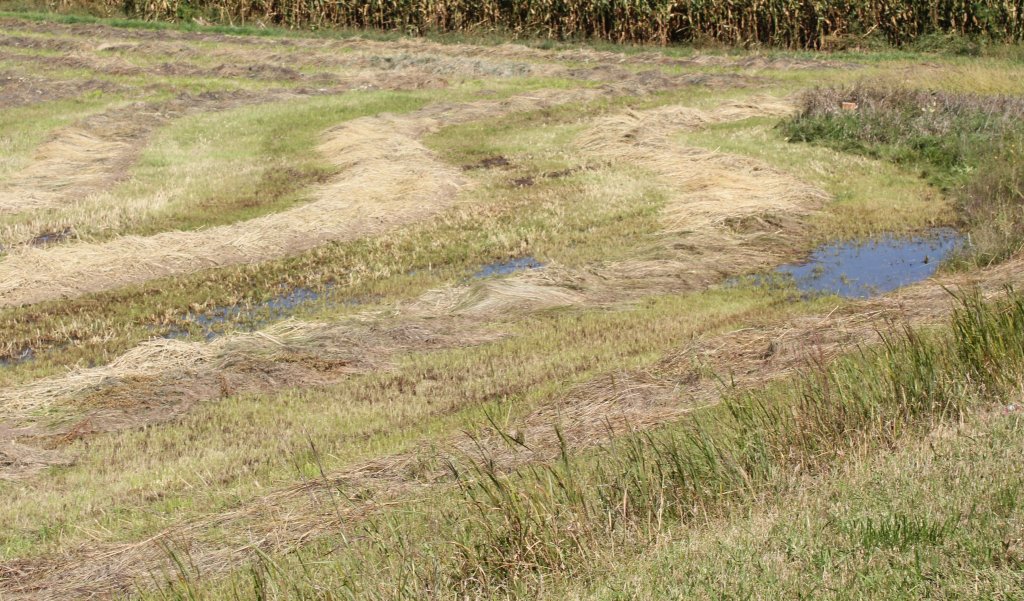
By Bruce Anderson, Nebraska Extension Forage Specialist
Damaged, rained-on hay. Nearly everyone has to feed it sometime. How should your feeding practices be adjusted, though, to account for any damage caused by the rain?
Rain can have numerous effects on hay. Besides disrupting your harvest plans, the end product usually is not as valuable a feed as planned. Furthermore, there are no good guidelines that can accurately estimate the amount of damage or the actual feeding value.
Factors influencing rain damage are just too variable. Amount of rain, length of the rain event, number of rain events, dryness of windrow prior to rain, drying conditions after rain, raking/turning windrows between rain and baling, moisture of hay when baled, and quality of hay when cut all affect hay condition.
MOLD: Mold commonly is found in rained-on hay. Often the hay was baled too wet, either to avoid further rain damage or just to remove it from the field to reduce its impact on regrowth.
Feeding moldy hay to livestock is a tough decision. Although all hay contains some mold, when mold becomes easily noticeable the decisions become important.
Usually, mold makes hay less palatable, which can result in lower intake or even cause animals to refuse to eat the hay. Other problems from mold can occur due to mycotoxins produced by certain mold fungi. This also is part of the decision problem since not all molds produce mycotoxins and the amount produced by those that do is unpredictable. Fortunately, mycotoxins rarely are present in hay unless mature seed heads or weed seeds are present.
Laboratory analyses for molds and mycotoxins are available but are relatively expensive. Often each mycotoxin must be measured individually, which increases the expense and it risks failure to test for the correct mycotoxin. Also, the test is based on the sample of hay provided. Usually, forage quality samples are gathered to estimate the ‘average’ feeding value of the hay. When sampling for potential toxins however, whether it’s mycotoxins or nitrates, it often is better to gather samples from what is thought to be the bales and areas within bales that are expected to be the most dangerous. Then feeding strategies can be developed to protect animals from what might be their worst case scenario in terms of toxicity.
Direct negative effects of moldy hay are difficult to document. Horses may be the most sensitive to mold among common livestock. For instance, mold spores often contribute to respiratory and digestive problems like colic or heaves in horses. Cattle apparently are less affected by mold, but certain molds can cause mycotic abortions or aspergillosis. People, too, can be affected by mold spores. Mold can cause a condition called farmer’s lung, where the fungus actually grows in lung tissue. So try to avoid breathing in many of these spores.
The best course of action often is to minimize feeding moldy hay to more sensitive animals, like horses or pregnant cows. This may require a keen eye or sensitive nose when selecting hay to feed each day. Mixing moldy hay with other feedstuffs can dilute problems sometimes, but be careful that you don’t make your animals sick by tricking them into eating bad hay that they normally would refuse.
HEAT DAMAGE: Hay baled too wet also is susceptible to heat damage, also called enzymatic browning. It is caused by heat produced by microorganisms in the hay as they use plant sugars and oxygen. If enough heat is produced to raise hay temperature above around 125 oF, chemical reactions occur that combine amino acids from protein with sugars in the hay to produce compounds similar to lignin. These heat-damaged protein compounds are poorly-digested but often smell sweet like caramel, turn hay to a tobacco-brown color, and produce various flavors that livestock often find very palatable.
Although livestock may eat heat-damaged hay readily, the nutrition they obtain from the hay can be surprisingly low. Microbes rapidly deplete the most readily available energy compounds in the hay. Standard forage tests can predict the remaining energy available from heat-damaged hay but standard tests cannot distinguish between usable crude protein and heat-damaged protein. Thus, standard tests may greatly overestimate the usable protein in the hay.
Special laboratory tests are available, though, that can measure heat-damaged protein and then adjust crude protein values. Terms used for these tests include acid detergent insoluble nitrogen (ADIN), acid detergent fiber crude protein (ADF-CP), and insoluble crude protein (ICP). When heat damage is suspected, request that the laboratory conduct this test and adjust crude protein accordingly for more accurate feeding.
NUTRIENT CONCENTRATION: Rain damages hay several ways. It leeches soluble carbohydrates, proteins, and minerals out of the hay. Leaves are lost. Extended drying time reduces carbohydrates due to plant respiration and microbial activity.
Most often, fiber concentration increases and crude protein concentration remains about the same after hay has been rained on. Digestibility and energy usually decline. Some vitamin A and minerals are reduced. The increase in fiber concentration is due to it becoming more concentrated in the hay as soluble carbohydrates and other components leech from the hay; more fiber is not being made.
The amount of change in nutrient concentration is very unpredictable. As a result, laboratory analysis for nutrient content can be especially valuable for rained-on hay. Nutrient content can change over time due to factors like the mold or heat damage discussed earlier so collect samples for laboratory analysis shortly before the hay is to be fed to have the most accurate estimate of what is available for the animal’s diet. These values then can be used to add appropriate supplements as needed to the diet.